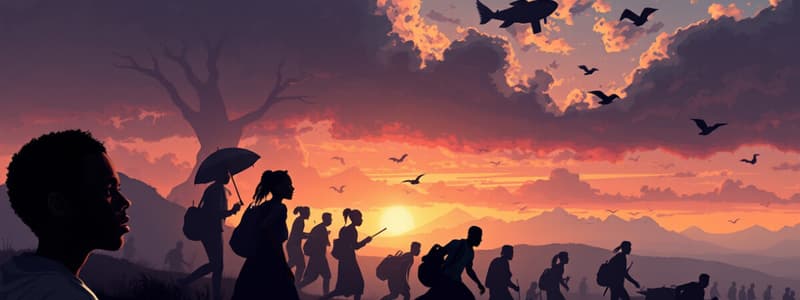Podcast
Questions and Answers
What was the Great Migration?
What was the Great Migration?
- The movement of African Americans to the Southern United States
- The movement of African Americans from the rural South to urban areas (correct)
- A migration of Europeans to America
- The immigration of Asian populations to the United States
What was the Scottsboro Case?
What was the Scottsboro Case?
A legal case involving nine African-American teenagers accused of raping two White American women.
The Red Scare occurred after the rise of the Bolsheviks in Russia.
The Red Scare occurred after the rise of the Bolsheviks in Russia.
True (A)
What were the Palmer Raids?
What were the Palmer Raids?
Sacco and Vanzetti were convicted based on substantial evidence against them.
Sacco and Vanzetti were convicted based on substantial evidence against them.
What was the purpose of the Sheppard-Towner Act?
What was the purpose of the Sheppard-Towner Act?
The Lost Generation refers to which group?
The Lost Generation refers to which group?
What does the Harlem Renaissance represent?
What does the Harlem Renaissance represent?
What did the National Origins Act establish?
What did the National Origins Act establish?
What characterized the New Klan in the 1920s?
What characterized the New Klan in the 1920s?
Flashcards are hidden until you start studying
Study Notes
Great Migration
- Movement of African Americans from rural Southern U.S. to urban Northeast, Midwest, and West from 1910 to the 1970s.
- First Great Migration (1910-1930) saw around 1.6 million migrants seeking better opportunities due to segregation, violence, and lack of jobs.
- Influx led to competition for housing and jobs, often causing tension with European immigrants.
Scottsboro Case
- In 1931, nine African-American teenagers, known as the Scottsboro Boys, were falsely accused of raping two white women in Alabama.
- No medical evidence supported the claims; despite this, they were convicted, prompting international protests.
- The case highlighted systemic racism in the American legal system and contributed to discussions about fair trial rights.
Red Scare
- Sparked by fear of communism taking hold in America post-Bolshevik Revolution in Russia; pervasive anti-communist sentiment emerged in 1919.
- Triggered by anarchist bombings, leading to widespread panic about socialists, anarchists, and immigrants.
- Resulted in actions like the Palmer Raids and the rise of the Ku Klux Klan, along with anti-foreigner legislation.
Attorney General Palmer/Palmer Raids
- Series of raids conducted by the U.S. Department of Justice aimed at capturing and deporting radical leftists and anarchists.
- Occurred under Attorney General A. Mitchell Palmer in November 1919 and January 1920.
Sacco and Vanzetti
- Italian anarchists Nicola Sacco and Bartolomeo Vanzetti were wrongfully convicted of a robbery and murder in South Braintree, Massachusetts, in 1920.
- Executed in 1927 despite a lack of substantial evidence, their case reflected racial and xenophobic biases in the U.S. justice system.
Sheppard-Towner Act
- Enacted in 1921 to reduce maternal and infant mortality rates by providing federal funding for maternity and childcare.
- Encouraged states to create programs aimed at assisting lower-income women with healthcare services.
Lost Generation
- The term describes a group of American writers who came of age during World War I and critiqued postwar American values.
- Originated from Gertrude Stein’s comment to Ernest Hemingway, indicating a sense of disillusionment and spiritual alienation among this generation.
Harlem Renaissance
- Cultural, social, and artistic explosion in Harlem between World War I and the mid-1930s, fostering a vibrant black cultural identity.
- Featured contributions from black writers, artists, musicians, and intellectuals, promoting pride and addressing themes of race and identity.
National Origins Act
- A key component of the Immigration Act of 1924, establishing a restrictive quota system for immigrants based on their country of origin.
- Discriminated against southern and eastern European immigrants and effectively excluded Asian immigrants; this act was repealed in 1965.
The New Klan
- The resurgence of the Ku Klux Klan in the 1920s expanded its focus beyond African Americans to include targeting Catholics, Jews, and immigrants.
- The Klan promoted fundamentalism, strong nationalism, and white supremacy as part of its platform for social influence.
Studying That Suits You
Use AI to generate personalized quizzes and flashcards to suit your learning preferences.




